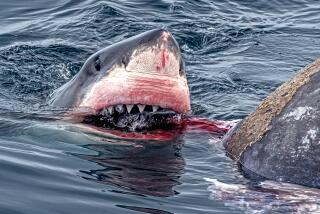What if Whales Came, but Folks Stayed Home?
- Share via
ABOARD THE FREELANCE — Frustration edged into Tyler Johnson’s 6-year-old voice. Three times a whale had surfaced, its tail flipping above the water as it dived downward. Three times the people around Tyler had oohed and aahed.
But three times Tyler was looking in the wrong place.
“Wow, did you see that?” someone said. “That was a nice one.”
“No!” Tyler yelled, laying his head down on the railing. “I think there is no whale.”
If luck can be reduced to timing, then Saturday was a lucky day. The swells were steady and slight, the air warm and the brilliant sunshine melted away thoughts of El Nino, for a few hours anyway.
And there were whales.
And for a change, there were people to watch them.
Whale-watch organizers say El Nino-driven winter storms have cut the whale-watch business by as much as 30% this season. A higher number of heavy storms has kept the boats at dock more often than usual. And on stormy days when the boats have gone out, only the hardiest whale-watchers have been aboard.
The problem is that people who watch video clips of waves breaking over houses from San Clemente to Malibu tend not to nip down to the docks and hop on a whale-watching ship.
But that, said Norris Tapp, manager of Davey’s Locker in Newport Beach, is because landlubbers don’t know the sea. Pounding surf on television usually just means bigger swells out on the open water.
“Local people who are knowledgeable about the ocean and what the storms are all about, they realize that in some cases it’s not as drastic as it might appear,” Tapp said. “There are swells out there, and the swells are larger than you would see in [the summer], but it’s not out of the ordinary for this time of year.”
For those who have gone out, the rewards have been plenty.
Experts say this has been a banner year for the gray whales that migrate along the California coast, with record numbers of sightings by volunteers for the American Cetacean Society.
As of Feb. 15, spotters had seen 1,295 whales, topping the previous season-high 1,291 in 1986-87. Spotters also counted 106 newborn calves on the southbound leg of the migration, up from last year’s record count of 44.
*
Tony Nichols of Huntington Beach, a Cetacean Society docent, said there is no clear reason for the increased number. He said speculation runs from increased water temperatures leading mothers to calve further north, to healthier birth and survival rates among the growing population of whales.
“On my first trip out, I saw [a baby], and I bet the thing wasn’t 2 days old,” said Gene Meister, captain and owner of Los Angeles Harbor Cruises in San Pedro. “The mother was being very careful with it.”
On a 2 1/2-hour outing Saturday morning, the Freelance, with Tapp at the helm, spotted two whales, one of them a small juvenile. The previous day the crew spotted 14 whales, part of the largest migration in the 18 years the Cetacean Society has kept count using volunteer spotters on the bluffs of Palos Verdes.
“We’ve seen a high number of juveniles, for some reason, from yearlings up to 3 to 4 years old,” Tapp said. “There’s an inordinate number of them, which is a good indication for the whales. There’s a lot of juveniles out there and they’re comfortable enough to migrate close to shore.”
But first the boats have to get out to sea, which has not been easy. Some days the weather’s too rough to go out safely. Other days, the seas are safe, but too rough for good sightings.
“You can’t see the whales if there’s much of a chop,” Meister said. “It just doesn’t do any good to run out there.”
In Dana Point, a village built on whaling, the weather has been equally bad.
“We’ve lost Saturday or Sunday pretty much every single weekend,” said Donna Kalez, general manager of Dana Wharf Sportfishing.
The whales themselves pay no heed. Boats off Dana Point report seeing about nine whales a day.
“Whale sightings have been excellent,” Kalez said. “We’re seeing lots of cow and calf pairs.”
*
Even with the high number of sightings, seeing whales takes a certain amount of persistence and patience. Six-year-old boys are not known to have deep reserves of either.
Tyler Johnson was aboard the Freelance on Saturday as part of an outing his mother, Laura Lyn Johnson, arranged a month ago for Tyler’s Tiger Scouts troop from Orange. There were 25 people in the group, mostly families of the five Tiger Scouts. As the date for the outing neared, Johnson said, she had some doubts it would actually take place.
“When I made the reservations, it was before all the storms,” Johnson said. “We just lucked out. We just kind of crossed our fingers. We knew they’d give us a rain check, but a lot of [the group] wouldn’t have been able to come back.”
Turns out they didn’t have to.
With bright sunshine glistening off calm seas, Tapp moved the Freelance slowly northward at about four knots, pacing the juvenile whale as it swam near Balboa Pier. Two other whale-watching boats were lined up abreast, and a parasailor glided overhead as all eyes scanned the sea for the telltale burst of vapor.
And there it was--a low cloud of vapor, then a gray back cresting the water before disappearing as the tail rose from the sea, gave a little flip and slipped beneath the water.
“I saw him! I saw him!” Tyler shouted excitedly, looking around for his mother and then giving her a quick high-five.
With a broad smile of satisfaction he turned back to his spot at the rail, eyes glued again on the sea, basking in the brilliant sunshine and the warming glow of success.
Scott Martelle can be reached at (714) 966-5974. His e-mail address is [email protected].



